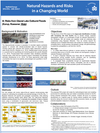PhD-Project I4 by Georg Veh (UP): Changing risk from glacial lake outburst floods
Timescale: Oct. 2015 – Aug. 2019
Supervisors:
Prof. Dr. Ariane Walz, University of Potsdam
Prof. Dr. Oliver Korup, University of Potsdam
Dr. Sigrid Rössner, Helmholtz Centre Potsdam GFZ German Research Centre for Geosciences
Background A disproportionate increase in population in mountainous regions worldwide currently coincides with climate-accelerated rates of natural hazards (Clagues et al. 2012). Glacial lake outburst floods (GLOFs) are an example for such a hazard. GLOFs are a special case of flooding that results from sudden release of meltwater ponded behind natural dams, and their connection to climate change are intensely debated (Haeberli 2013). Glacial meltwater lakes occupy the highest parts of a mountain range, so their potential energy can be transformed to hazardous and highly destructive flows (e.g. Huggel et al. 2011). The combined effects of increased human exposure (and thus vulnerability) and climate change on GLOF hazards and the corre-sponding changes to hazards and risk are subject of this proposal. Although satellite-based remote sensing is an efficient analysis and monitoring tool (e.g. Bolch et al., 2011), remaining uncertainties are substantial because of the complexity of the involved processes and the limited temporal repeat rate of data acquisitions. The same holds for dam-age potential from an increase in development as well as urbanization of mountain areas (e.g. Nussbaumer et al. 2014, accepted). Additional uncertainty pertains to GLOFs that are recon-structed from remotely sensed data and to future GLOFs projected from corresponding cli-mate simulations.
Objectives and Methods
We explicitly acknowldege these considerable uncertainties by employing a Bayesian Network (BN) approach for estimating GLOF risk at test sites. We used both a data driven BN learning process as well as an expert-based network structure. The PhD-project aimed at quantifying the contemporary and future risk from glacial lake outburst floods for selected sites in the Himalayas. Such risk appraisals are rare, though highly desirable in times of rapidly melting mountain glaciers and commensurately expanding meltwater lakes. Methods for this project involved analyses of repeat satellite imagery, modelling of lake outburst and flood propagation, simulation of land-use and population scenarios, and assessment of these transient variables and their uncertainties using Bayesian networks.
Main results
- We developed a robust algorithm to detect automatically Glacial Lake Outburst Floods (GLOFs) in the Himalayas and adjacent mountain belts from a time series of Landsat images. With this method we generated the first systematic GLOF inventory for the region from 1988-2017.
- The method was able to more than double the existing GLOF count in the greater Himalayan region, and identified the southern Himalayas (mainly of Nepal and Bhutan) as a hotspot of GLOF activity in the past 30 years. Both overall and regional GLOF frequencies remained unchanged in this period despite ongoing glacier melt and growth of meltwater lakes in most of the study area.
- We proposed a first objective GLOF hazard appraisal for existing and projected future meltwater lakes in the Himalayan region. Estimates of the 100-year GLOF discharge assign the highest contemporary GLOF hazard to the southern Himalayas, consistent with the highest GLOF rate in the past three decades in that region.
Publications within NatRiskChange:
VEH, G., O. Korup, S. Roessner, A. Walz. (2018). Detecting Himalayan Glacial Lake Outburst Floods from Landsat time series. Remote Sensing of Environment, 207, 84-97. doi.org/10.1016/j.rse.2017.12.025
VEH, G., O. Korup, S. von Specht, S. Roessner, A. Walz (2019): Unchanged frequency of moraine-dammed glacial lake outburst floods in the Himalaya, Nature Climate Change, 9, 379–383. doi.org/10.1038/s41558-019-0437-5
VEH, G., Korup, O., Walz, A. (2020): Hazard from Himalayan glacier lake outburst floods. Proceedings of the National Academy of Sciences: first published December 30, 2019 https://doi.org/10.1073/pnas.1914898117
von Specht S., Ozturk U., VEH, G., Cotton F., Korup O. (2019): Effects of finite source rupture on landslide triggering: The 2016 MW 7.1 Kumamoto earthquake. Solid Earth, 10, 463-486. doi.org/10.5194/se-10-463-2019.
Thesis to download:
Outburst floods from moraine-dammed lakes in the Himalayas - Detection, frequency, and hazard

